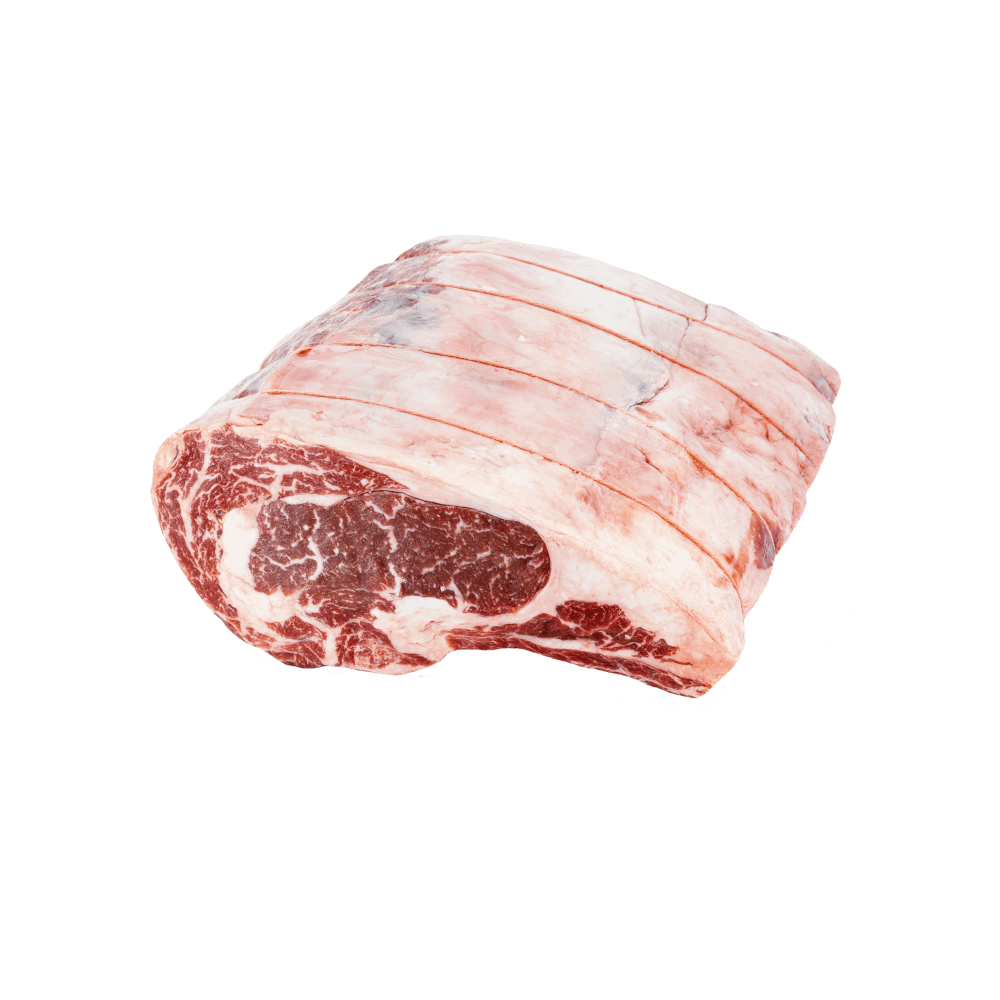For those of you who have ever struggled when carving the cooked rib roast, this ‘boned and tied’ roast is the answer. When done properly, you can’t even tell that the ribs have been separated. Our butchers do the tricky work of cutting the meat off the bones, then tie the bones back onto the roast. The cooking process will be exactly the same and there will be no loss of juice because the ribs are seating back exactly where they were and will seal the roast while cooking. When done, simply cut the strings and lift off the meat… Voilà! You have a boneless roast to slice and the ribs will be fully cooked and servable if desired. You will also find that you can get even more servings when the roast is prepared this way.
As far as I am concerned, this is the origin of the species (since I spoke of Creationism with the Rib Cap, I feel that I must give Darwinism a nod with the Prime Rib). In my humble opinion, most all of the flavor in beef spends its life migrating to the Prime Rib. I need to set the stage here a little bit so let’s talk about the Prime Rib in general.
In 12 words or less, the prime rib is a whole family of Rib Steaks left together.
Interesting little point here; although the actual cut is called the PRIME Rib, it will come in the same grade levels as other cuts, namely Prime, Choice, Select, and all the way down to “Whoa Nelly.”
As far as I am concerned, this is the origin of the species (since I spoke of Creationism with the Rib Cap, I feel that I must give Darwinism a nod with the Prime Rib). In my humble opinion, most all of the flavor in beef spends its life migrating to the Prime Rib. I need to set the stage here a little bit so let’s talk about the Prime Rib in general.
In 12 words or less, the prime rib is a whole family of Rib Steaks left together.
Interesting little point here; although the actual cut is called the PRIME Rib, it will come in the same grade levels as other cuts, namely Prime, Choice, Select, and all the way down to “Whoa Nelly.”
The rib runs from the shortloin (where you’ll find the New York Strip Steak and Porterhouse) up toward the shoulder (or ‘Chuck’). Nowadays, these sections are produced with a total of 7 ribs. Years ago you’d get 8 ribs, but in today’s production the first rib (or last) is left on the shortloin. My guess on this is that since the shortloin generally carries a higher price tag, beef processors figured out they could shift roughly 4 pounds from a lesser priced cut (relatively speaking) to one that sells for more.
Another major change from earlier years is the notion of the “1st cut.” Way back when, the Prime Ribs came to butchers with a whole lot more meat on them than they do today. The culprit behind this, you might ask? Look no further than the Boneless Short Ribs that have become an increasingly popular cut. Before the Short Ribs were removed from the Prime Rib, that extra beef would cause the diameter of the Prime Rib to increase starting from the loin end (the 1st cut), and the percentage of pure Rib Eye to net weight would move from 100% to somewhere around 60%. This is why our parents and grandparents would ask the neighborhood butcher for the 1st cut – to ensure that they were receiving the cut with the purest ribeye flavor. But take note: that concept is a thing of the past, and if you were to ask for the smaller end today, you would be getting the section of the shortloin that is closer to the chuck.
The Prime Rib is the classic beef roast and although there are a number of other excellent roasts, the rib is the most dramatic by far in terms of presentation and flavor. Some practical points to consider; the “loin end” will have less chunks of fat, longer ribs, and the spacing between the ribs will be greater than the same facets of the “chuck” end. The chuck end by virtue of the greater percentage of the Rib Cap will deliver the more intense flavor than will the loin end. Either way, it’s a winner!
The average individual rib (a full Prime Rib has 7 ribs) will weigh about 2 pounds to 2.5 pounds each and will serve 2-3 adults easily. Here is something to consider when sizing the cut you need: the Prime Rib has a large diameter to the eye of the meat; so a half-inch cut from the Prime Rib will weight a lot more that a half-inch cut from say the New York strip. So be careful when ordering by weight; what I mean by this is that if you were sizing a Filet Mignon roast, I would advise at least a half a pound of meat (finished cooking weight) per person. But if you apply this to the Prime Rib, a half pound of meat would be a slice maybe 3/8” thick. Our recommendation is to assume between 1-1.25lbs per serving when looking at this cut.

